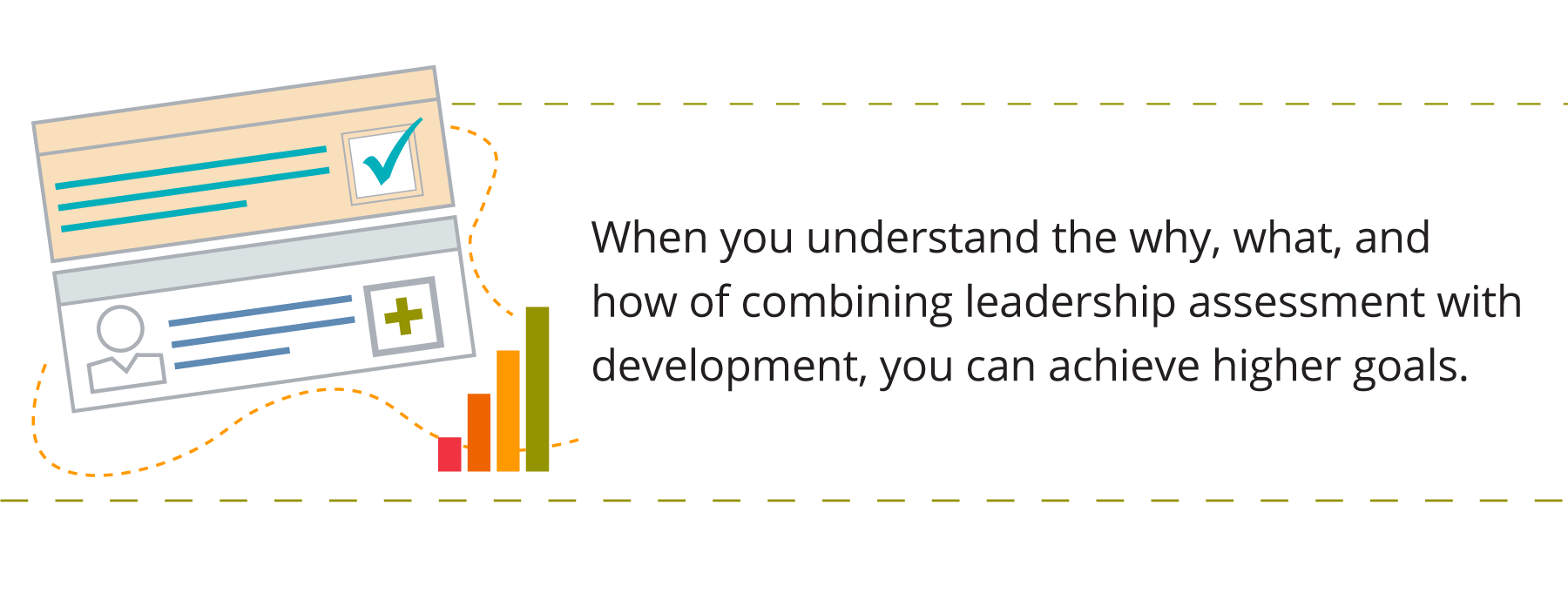When 1+1 = 3
As is often said, “The whole is greater than the sum of its parts.” In other words, when the combination is just right, 1+1 can equal 3, or possibly more. And that’s the kind of math you see when combining assessment and development.
Too often, we see companies separate their assessment and development strategies. Different teams of people may lead each part and may have different purposes. But bringing these two pieces closer together offers a lot of opportunity.
When you understand the why, what, and how of combining leadership assessment with development, you can achieve higher goals.

The Why: The Value of Combining Assessment and Development
One of the key issues of leadership development is knowing where to start. You don’t want to waste leaders’ time with things they are already good at. But you don’t want to leave any gaps either.
Assessment data makes the strengths and gaps in your organization clear. Based on our experience, there are specific benefits to combining assessment and development. Organizations make the most of their efforts when they:
- Invest where it matters most. When assessment data is used as a starting point for designing development programs, you can spend your budget, time, and other resources on addressing and developing critical skill gaps. You decrease the risk of spending valuable resources on building the wrong capabilities.
- Personalize development. Research shows that leaders’ top preference is for personalized development instead of a generic, one-size-fits-all approach. Assessment data can zoom in on specific strengths to build or gaps to close. This becomes especially important when leaders also say that time is the biggest barrier to learning and development. You can personalize development at two levels:
- Build skills at the competency level. Which competency should a leader focus on? Leading change? Coaching? Influence? It depends on what they are good at and where they need to improve. Assessment data can determine organizational gaps as well as individual priorities.
- Add precision at the behavioral level. Within a given competency, an assessment can enhance precision. For example, two leaders might need to improve their coaching skills for different reasons. One leader may need to give more timely and specific feedback, while the other struggles to involve others. Assessment data can help pinpoint what behaviors the leader should focus on to accelerate their development.
- Engage leaders in their development. Recent research shows that 15,000 leaders want more assessments to determine strengths and gaps. In fact, it was ranked third on their wish list, just behind external coaching and assignments. Assessment data can serve as a catalyst for change by providing meaningful insights into their strengths and development areas. Leaders can reflect on what’s working or not, and fully embrace development plans. This engagement, plus personalization, sets individual assessment apart from a generalized needs analysis.
- Track measurable change. With baseline assessment data, you can gauge the impact development has on an individual leader or group of leaders.
The What: What to Assess and How to Develop
You should answer two questions when thinking about combining assessment and development:
- What’s the purpose of the assessment?
- How will the data be used?
Specifically, are you looking for a robust assessment that gives leaders deep insight into their capabilities and attributes? Or do you need a lighter, less costly assessment that provides only a broad view of strengths and development needs?
The answers depend on how the data will be used and in the development effort’s rigor. Development aimed at making incremental improvements to a general set of skills may only warrant a light assessment.
However, a deeper transformational leadership experience, such as for a high-potential leader, requires the precision of a higher-quality assessment. This might include an assessment center, which includes simulations, personality measurement, and interviews.
You might also be wondering whether assessment should drive development priorities, or the other way around. Most of the time, it can go either way.
- Development priorities can drive assessment. When you already know which competencies you want to focus on, you can look for an assessment as a form of feedback. That way, you know if people are really showing the behaviors they learned about. For example, you might have a set of core competencies that all leaders need to demonstrate. After putting them through a learning journey focused on those areas, you might launch a 360-degree feedback assessment to see how they are performing on the job.
- Assessment can drive development priorities. Assessment data can determine which areas your leaders should develop in as individuals or a group. For instance, a leader might use their results to build a personalized individual development plan, often with the support of their manager. Meanwhile, HR can be looking at the data across leaders to launch effective group-based development.
When combining assessment and development, we recommend that the assessment is competency-based or focused on behaviors. This way, the data and insights are actionable since the leader can develop that skill or behavior.
In contrast, a personality test alone may not be the best assessment tool to pair with development. A personality test certainly has value. But it won’t lead to actionable insights without being paired with a behavioral assessment.

The How: Planning to Combine Assessment with Development
Your implementation plan is crucial for success. There are some actions necessary when combining assessment with development, including:
Get buy-in and alignment.
You need a compelling value proposition for leaders and internal stakeholders. Communication, engagement of learners, and active involvement of senior leaders will help drive commitment and deliver results. To sustain development efforts and show impact, make sure you have answers to key questions:
- What will be participants’ required follow-up steps?
- Who will be accountable for what outcomes?
- How will you measure success and impact?
Set clear expectations.
Build excitement about your integrated program by clearly outlining what’s coming and why. It’s especially important since assessments can create a range of emotions in leaders. Some will be excited about the opportunity, while others may feel anxious.
Make sure you explain four key points to leaders:
- Why they’re being assessed
- Who will have access to the data
- How their assessment results will be used (and not used)
- What development opportunities are planned
It’s also important to set expectations around the assessment experience itself. A leader will want to know what to expect from the experience, what to complete, how much time to invest, who to contact for any concerns, and the next steps.
Establish a data sharing policy.
One of the biggest concerns your leaders will have is who will have access to the assessment results. They’ll want to know who can see their data and how those people might use it. That’s why it’s so important to establish your data-sharing policy in advance. And of course, you have to strictly abide by the policy afterward.
When assessments are used for development purposes, many companies choose to make the individual assessment results available to the leader only. Meanwhile, HR can only view the aggregate data.
While that approach protects individual data tightly, it leaves out the opportunity for manager involvement. That’s why other companies allow the leader’s manager or coach to see the data, so they can provide additional support.
Different approaches can work, but the important thing is that you communicate them clearly and stick to them.
Proactively plan for feedback and development planning.
Don’t wait until after the assessments are complete to start thinking about your development program. Depending on the type of assessment tool, you can schedule one-on-one feedback sessions with leaders to walk them through their assessment results and translate the feedback into an individual development plan. Some assessment reports can be self-explanatory, but many require additional support.
Involve direct managers.
Find ways to engage and bring managers in as part of your integrated program. You can encourage leaders to share results or key insights from the assessment and their draft development plan with their manager.
That way, their manager can work with them to refine and finalize the plan with unique development opportunities or assignments. During these discussions, the manager can also identify ways to remove any barriers or provide ongoing support.
